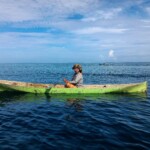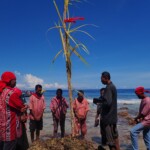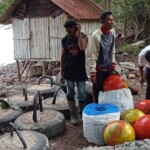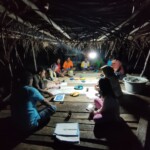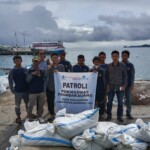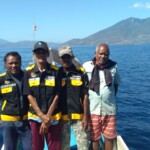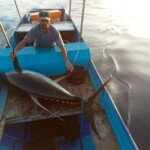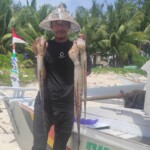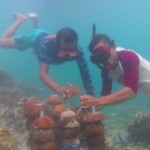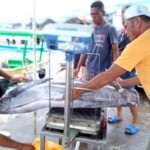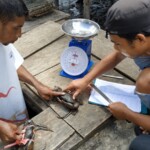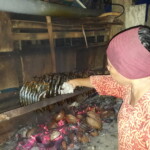Midterm Review Wallacea Partnership Program II

Creating and Strengthening the Community-Based MPA
In many projects, the most effective starting place for building this capacity was the traditional knowledge already present within the community to address open-access over exploitation by set and enforce limits on harvest.
Rediscovery of traditional resource management norms, revitalized and adapted norms became the basis for widely accepted rules on resource management. In other cases, ideas from external sources – other communities, researchers, Government – are valuable, and need to be introduced and communicated in ways that are appropriate and applicative.
Among others were projects in KBA Wabula in Sulawesi Tenggara marine corridor, KBA Pantai Selatan Lebau and Teluk Hadakewa in Solor-Alor marine corridor, KBA Haruku, Saparua, Nusalaut and KBA Kelang-Kassa-Buano-Marsegu in Buru marine corridor.
As a result, more than 70,000 ha marine area are better managed with clear regulation on harvest limitation, fishing gear and zones, local or customary monitoring groups/patrols, and increased knowledge and sustainable practices by the community. This has brought impact to reduced number of destructive fishing, reduced number of illegal and unsustainable harvest (e.g. Napoleon wrasse, parrot fish, white teatfish), reduced bycatch (e.g green turtle, hawksbill turtle).
The fishermen gained better access and protection from the government, such as the 384 people whom registered within the government system (KUSUKA) and the registered boat of 192 people. Regarding income, we recorded increased income of at least 10 USD/month for the community groups in 4 villages. Moreover, these local MPAs are contributing to the government formal MPA, such as RZWP3K Kawasan Konservasi Perairan Zona MHA Wabula, Kawasan Konservasi di Perairan Flores Timur, Kawasan Konservasi di Perairan Lembata, Taman Pulau Kecil Kepulauan Lease, Taman Pulau Kecil Buano.
Supporting the Government Formal MPA
The Government of Indonesia has established more than 24 million hectares of marine conservation area to achieve the global target of 32.5 million hectares by 2030, as well as the target of its effective management. Some projects have contributed to the effective management and implementation of the established marine conservation area, such as projects in Selat Pantar Marine Protected Area in Solor-Alor marine corridor, Liukang-Tangaya Marine Protected Area in Pangkajene Kepulauan marine corridor, and Banggai Dalaka Marine Protected Area in Togean-Banggai marine corridor.
Projects has develop the community capacities for participatory coastal monitoring and patrol to tackle destructive fishing, rehabilitation of coral reefs, establish agreement for sustainable fisheries (zones and fishing gears), knowledge and skills to practice sustainable fisheries, and build synergy with the government authority that manage the formal MPA.
As a result, more than 5,600 hectares of fisheries zones are better managed with the village regulations and community agreements that protect the mangroves, coral reefs, the octopus habitat and the Banggai Cardinal Fish habitat. At least four species are better protected through the village regulations and community agreements, e.g. the Napoleon wrasse and green turtle.
The community patrol has connected with the government authority and collaborated for joint patrol. About 70 m2 area of coral reef in Selat Pantar was rehabilitated using rock-piles, while 48.2 hectares coral reef in Banggai Dalaka that also the habitat of octopus was restored due to the harvest system management.
Moreover, 285 people have experienced the direct benefit of better management of MPA. In Banggai Dalaka, for example, the fishermen has increased fisheries production – the octopus harvest increased from 705 ton in 2017 to 1,080 ton in 2022; about 85 people have increased income from IDR 500,000/month (USD 34) to IDR 1,500,000/month (USD 102).
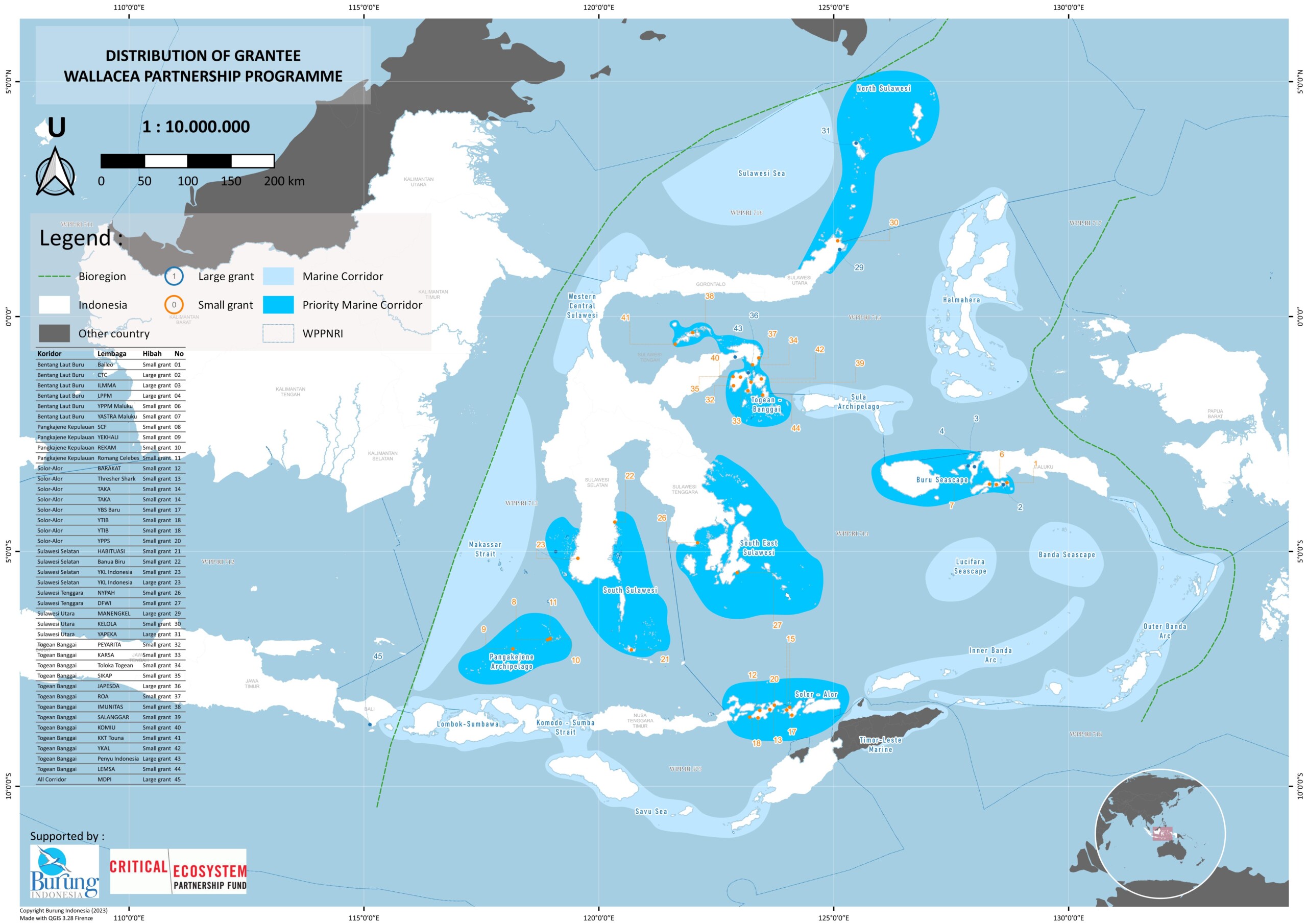
Contribute to Species Protection and Increase Production of the Fisheries Commodities
Action may be needed to address short-term economic needs which drive unsustainable exploitation and are a barrier to change. Addressing immediate practical needs felt by the community, and linking them to longer term environmental issues, was an important element in some projects.
In some cases, addressing ‘quick win’ community priorities enabled a grantee to establish a positive relationship with the community which allowed them to go on to deal with more intractable problems which are the higher priority for conservation, such as the projects in Solor-Alor marine corridor, Sulawesi Utara marine corridor, and Togean-Banggai marine corridor.
Through the project, community in two villages in Alor have shifted from harvesting the pelagic thresher (Alopias pelagicus) into yellowfin tuna by providing series of capacity building for 100 people on fisheries management and practice as well as community patrol. As a result, the number of hunted pelagic thresher was reduced from 233 individual in 2021 to 55 individual in 2022.
Meanwhile, another project has managed to stop the bycatch of dugong in two villages in KBA Perairan Sangihe (Sulawesi Utara) through strengthening the community-based MPA and its fisheries management. Through series of capacity building and assistance, both village governments have revised the village regulations and allocated a total of IDR 108,400,000 (USD 7,371) for CB-MPA management, for the cooperative startup capital, and for procurement of coastal monitoring. Moreover, the community cooperative has sold their first harvest 15 kg of sea cucumber IDR 3,000,000 (USD 204).
Similar approach was applied in Sulawesi Selatan marine corridor. By improving the octopus fisheries harvest management, the communities in two islands have increased income and access toward companies as well as reduced threats of six species (e.g. green turtle is no longer hunted) and maintaining the reef health.
Different approach was made in other projects. In Pulau Sapuka in Pangkajene Kepulauan marine corridor, project has able to reduce the unsustainable harvest and trading of Holothuroidea sp - two species among them are vulnerable - by using community participatory research as the entry point. In KBA Perairan Kepulauan Togean in Togean-Banggai marine corridor, the project introduced innovation of simple technology for reef rehabilitation (made from leftover coconuts) in 2 hectare area while also link the fishermen with private sector.
Increase the Community Livelihood and Contribute to the Small-Scale Fisheries Industry
Work on small-scale fisheries offers the opportunity to work directly on local livelihoods, which may have more tangible short-term benefits to communities than, for example, the creation of a no-take zone. In practice, notake zones and local MPAs are likely to be part of a wider community-based strategy for fisheries management. Where fisheries production is commercialized, the private sector has an important role to play in setting standards for the marine produce which it buys. Projects which aim to make linkages between markets and the standards for marine products, including building the skills and institutional capacity of fishers to enable them to participate in certification and sustainable fisheries schemes.
Among others were projects in KBA Perairan Balantak and KBA Perairan Peleng Banggai in Togean-Banggai marine corridor, KBA Selat Lembeh and KBA Perairan Likupang in Sulawesi Utara marine corridor. These projects started with the community livelihood of small-scale fishers with commodities such as tuna and giant mud crabs, the involvement of the women as the key player in the fishermen households, scaled into developing the management of the fishing zones and gear – some even contribute into formal MPA establishment, and linkages to market.
A total of 935 hectares of the fisheries zones are better managed with direct benefit to at least 315 people, ranging from increased income ranging from IDR 625,000 (USD 42) to IDR 7,205 (USD 485) resulting from transactions with private sector and direct selling in the neighboring villages and traditional market. Cooperation with private sectors were made between the communities with one private sector (PT Aruna) in Togean-Banggai, with Association of Fisheries Pole & Line and Handline Indonesia in Sulawesi Utara, and cooperative start-up for joint marketing in Togean-Banggai. At least 114 fishermen received better access toward government services through fishermen registration system (KUSUKA) and permit and the women groups received better access toward government services, such as equipment for producing fisheries food products (e.g. shredded fish, meatballs) and permit for marketing. One state-owned company in Sulawesi Utara granted IDR 75,000,000 (USD 5,282) for one women group to purchase production equipment.
Increasing community livelihood through better fisheries management has brought impact toward conservation. Among others were the reduced bycatch of the Ridley turtle (Lepidochelys olivacea), reduced egg-harvesting of the green turtle (Chelonia mydas), and reduced bombing. Moreover, the community awareness has increased so that, as example, the community in KBA Perairan Balantak built their own turtle hatchery while the community in Uwedikan village rehabilitated coral-reefs as much as 12.2 hectares and allocated 5% of the fishermen group income for conservation.



